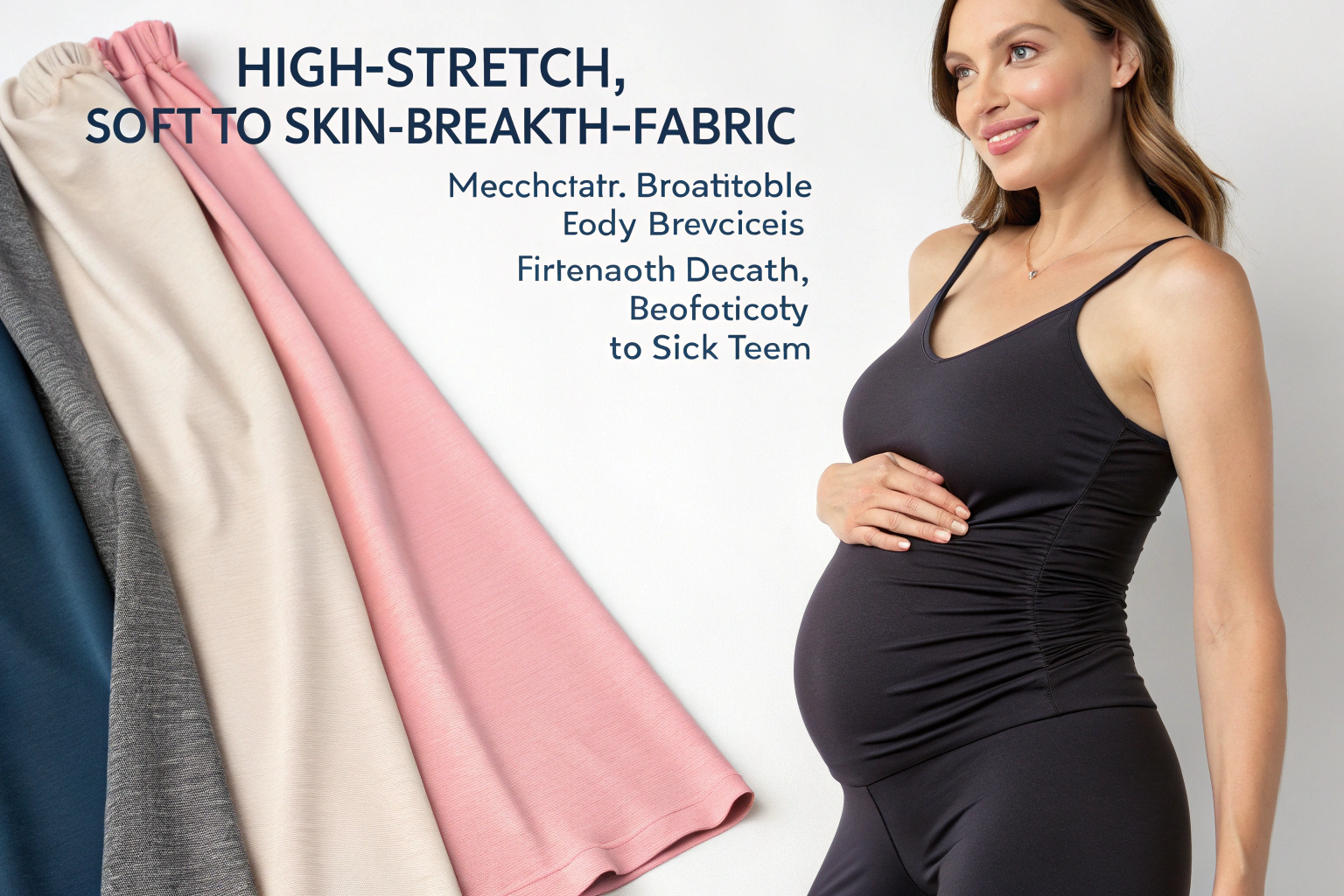As a maternity wear designer or retailer, you know that comfort is non-negotiable. Your customers are navigating a period of immense physical change, and the fabrics they wear play a crucial role in their daily well-being. The challenge is finding materials that can gracefully accommodate a growing bump, provide all-day ease, and still look and feel stylish. It's a delicate balance between elasticity, breathability, and durability.
The key to selecting the perfect fabric for maternity wear lies in prioritizing high-stretch, breathable, and soft-to-the-skin materials that can adapt to a changing body shape without sacrificing style or comfort. The best fabrics offer a combination of mechanical stretch from constructions like knits and intrinsic stretch from fibers like spandex, all while maintaining moisture-wicking properties and skin-friendly textures.
Having worked with countless maternity wear brands from our base in Keqiao, I've seen how the right fabric choice can transform a customer's experience. Let's dive into the essential fabric characteristics that make maternity clothing both a joy to wear and a smart business decision.
What are the best stretch fabrics for maternity wear?
When your body is changing week by week, stretch isn't just a feature—it's a necessity. The best stretch fabrics for maternity wear provide recovery, meaning they snap back to their original shape after being stretched, ensuring the garment maintains its fit throughout pregnancy and beyond. This is crucial for both customer satisfaction and minimizing returns for your brand.
The top-performing stretch fabrics for maternity wear are knitted constructions, which are inherently more flexible than wovens. Jersey knit, particularly from natural fibers like cotton or bamboo, is a superstar for its soft hand-feel and excellent two-way stretch. For more structured items like supportive leggings or pants, a cotton-spandex or polyester-spandex blend is essential, with the spandex content typically between 5-10% to provide the necessary give. Another excellent choice is interlock knit, which is thicker and more stable than jersey, making it ideal for maternity dresses and tops that require both comfort and shape retention.
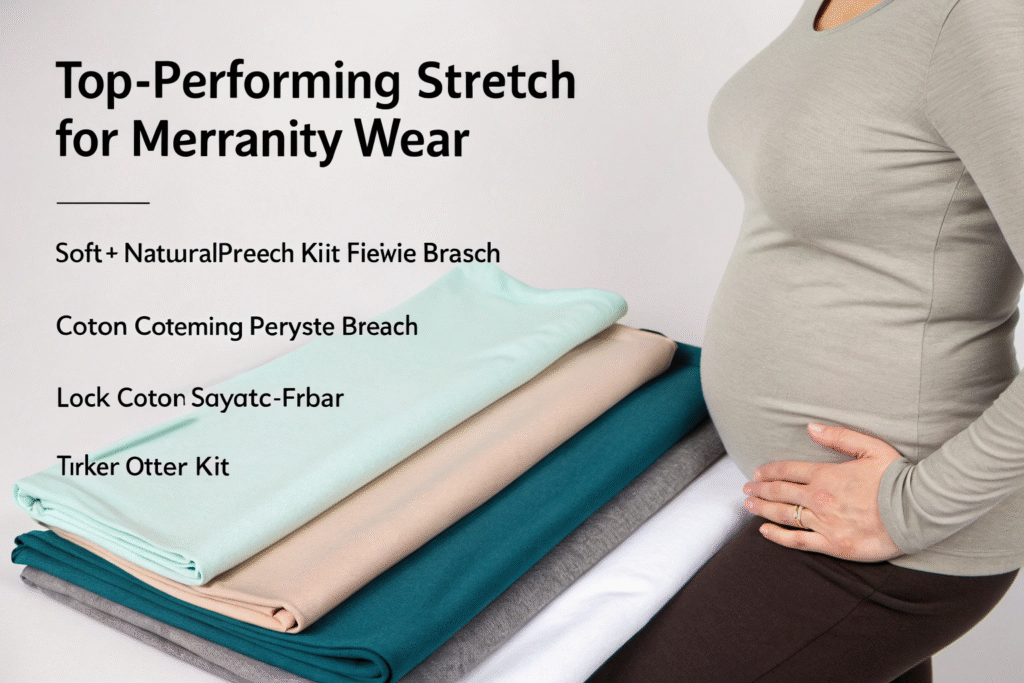
Why is fabric recovery crucial for maternity apparel?
Fabric recovery refers to a material's ability to return to its original shape after being stretched. In maternity wear, poor recovery leads to baggy knees in leggings, drooping elastane in waistbands, and clothes that lose their shape long before the end of their intended lifespan. This is a major pain point for consumers and a quality failure for brands. High-quality recovery means the garment will consistently hug the body's changing contours without becoming permanently distorted, providing reliable support and a flattering fit from the first trimester through postpartum.
How does fiber content influence stretch and comfort?
The base fiber of a fabric fundamentally defines its comfort and stretch characteristics. Natural fibers like cotton and bamboo are celebrated for their breathability and softness, making them gentle against sensitive skin. However, they lack inherent stretch. This is where synthetic fibers like spandex (also known as Lycra or elastane) become indispensable. By blending natural fibers with just a small percentage of spandex, you get the best of both worlds: the comfort and breathability of a natural fiber with the essential, durable stretch of a synthetic. For performance-oriented maternity wear, moisture-wicking fabrics like recycled polyester blends are excellent for keeping the wearer dry and comfortable.
How to ensure all-day comfort in maternity fabrics?
Comfort in maternity wear extends far beyond simple stretch. It encompasses how a fabric feels against the skin, how it manages moisture and temperature, and how its weight and structure interact with a changing body. A fabric can be stretchy but still be uncomfortable if it's itchy, stiff, or doesn't allow the skin to breathe. The goal is a holistic comfort that supports the wearer throughout her entire day.
Breathability is a cornerstone of all-day comfort. Pregnant women often experience fluctuations in body temperature, so fabrics that facilitate air circulation are vital. Natural fibers like cotton, linen, and bamboo are inherently breathable. Furthermore, moisture-wicking properties, often found in advanced micro-modal and certain polyester blends, actively pull sweat away from the skin to the fabric's surface where it can evaporate. This helps regulate body temperature and prevents the clammy feeling that can make clothing unbearable.
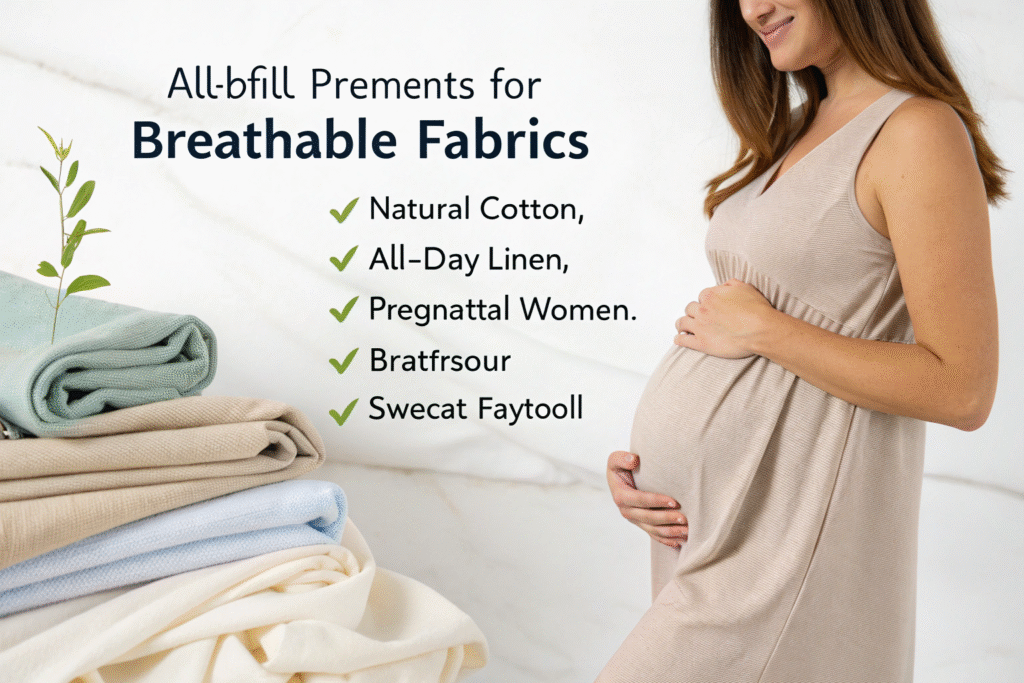
What makes a fabric truly breathable for maternity wear?
Breathability in fabrics is determined by the structure of the material and its fiber content, which together determine how well air can pass through and how effectively moisture vapor is released. Knitted fabrics are generally more breathable than woven ones due to the loops of yarn that create tiny air pockets. In terms of fiber, plant-based materials like organic cotton, linen, and bamboo are champions of breathability. Their natural cellulose structure allows for excellent air permeability, making them a top choice for maternity wear designed for warm climates or everyday basics that need to be worn for long hours.
Which fabric weights are ideal for different maternity seasons?
Selecting the right fabric weight is key to seasonal appropriateness and comfort. Weight is measured in GSM (grams per square meter) and dictates the thickness and warmth of the material.
| Season | Recommended GSM Range | Ideal Fabric Types |
|---|---|---|
| Summer / Warm Weather | 130-200 GSM | Lightweight cotton jersey, bamboo viscose, linen blends, lightweight interlock |
| Spring/Autumn | 200-280 GSM | Mid-weight jersey, French terry, ponte roma, double knits |
| Winter / Cool Weather | 280-400+ GSM | Heavyweight jersey, sweatshirting, ribbed knits, brushed fleece, wool blends |
A versatile year-round weight for maternity tops and dresses is between 180-220 GSM. For supportive bottoms like maternity leggings, a higher GSM (250-300) provides more opacity and support.
What are the top eco-friendly fabric choices for maternity wear?
Today's conscious consumer is increasingly looking for sustainable options, and maternity wear is no exception. Expectant mothers are often particularly motivated to make choices that are healthy for their bodies and the planet their child will inherit. Fortunately, the world of eco-friendly fabrics has expanded dramatically, offering high-performance, comfortable, and sustainable alternatives perfect for maternity clothing lines.
The leading eco-friendly choices for maternity wear include organic cotton, which is grown without toxic pesticides and is incredibly soft and breathable. Bamboo silk (BAMSILK) is another favorite for its ultra-soft, drapable quality and natural breathability. For items requiring more durability and stretch, Recycled Polyester (rPET) blended with spandex is an excellent choice, giving a second life to plastic bottles. Tencel™ Lyocell, made from sustainably sourced wood pulp in a closed-loop process, is renowned for its silky feel and superb moisture-wicking capabilities, making it a premium option for sustainable maternity fashion.
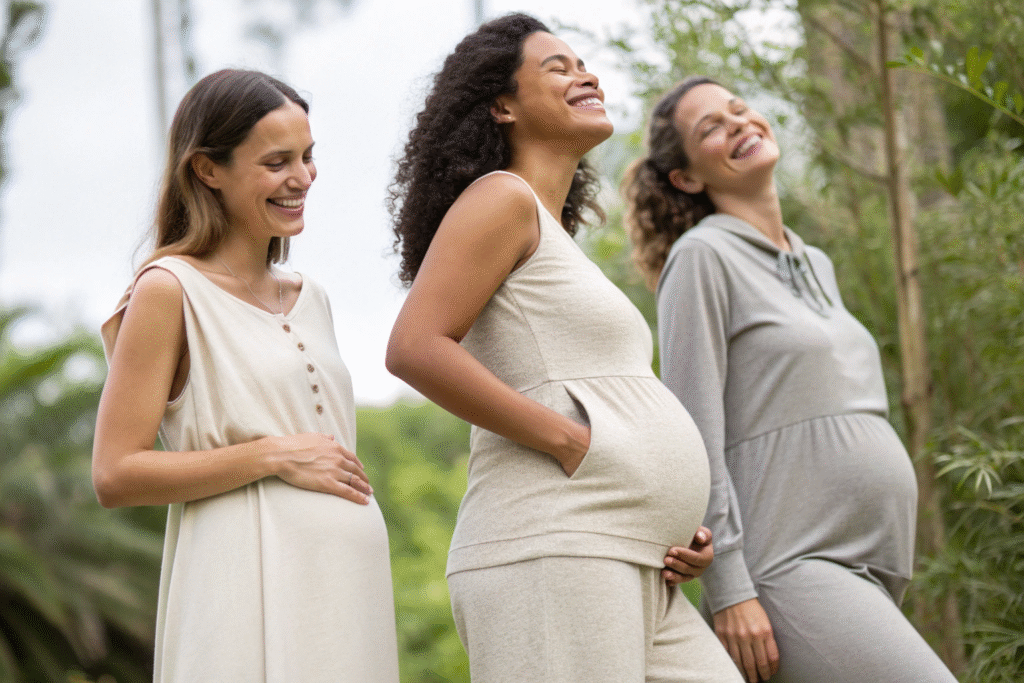
How do certifications like GOTS and Oeko-Tex benefit maternity wear?
Certifications provide verifiable trust signals for your brand and your customers. The Global Organic Textile Standard (GOTS) certifies that the entire textile supply chain, from harvest to finished fabric, meets strict ecological and social criteria. For a maternity wear brand, using GOTS-certified organic cotton assures your customers that the fabric is free from harmful chemicals. Similarly, the Oeko-Tex Standard 100 certification tests for a list of harmful substances, ensuring the fabric is safe for human skin contact—a paramount concern for both pregnant women and newborns. Promoting these certifications directly addresses a key buyer concern for safety and quality.
Why is bamboo fabric a popular sustainable option?
Bamboo fabric has gained immense popularity in sustainable maternity wear for several compelling reasons. Firstly, bamboo is a rapidly renewable resource that requires no pesticides and little water. The resulting fabric, often called bamboo viscose or rayon, is exceptionally soft, often compared to silk or cashmere. It is highly breathable and has natural thermo-regulating properties, keeping the wearer cool in summer and warm in winter. Its excellent drape and slight stretch make it ideal for flowing maternity dresses and soft, comfortable tops. However, it's important to source from suppliers who use environmentally responsible closed-loop processing to minimize chemical use.
How can I source quality maternity wear fabrics from China?
Sourcing fabrics from a global hub like Keqiao, China, offers immense advantages in variety, cost, and scalability, but it requires a strategic approach to ensure quality and reliability. The key is to partner with a supplier who understands the specific technical and comfort demands of maternity wear and can provide full transparency and control throughout the production process.
The most effective strategy is to work with an integrated supplier that manages the entire process, from fiber sourcing to finishing. This vertical integration allows for better quality control and faster turnaround times. For maternity wear, it is critical to request and test fabric samples for key performance attributes like stretch recovery, colorfastness, and pilling resistance before placing a bulk order. A reputable supplier will have a CNAS-certified lab to conduct these tests and provide reports, giving you confidence that the fabric meets international safety and quality standards like those from SGS.
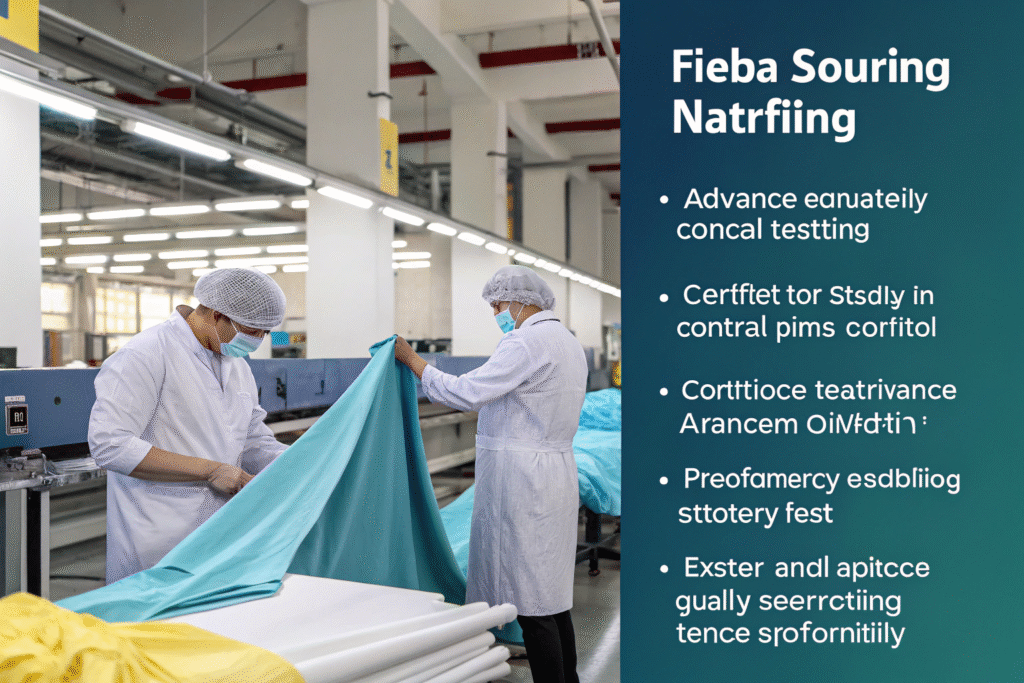
What quality control checks are vital for maternity fabrics?
Rigorous quality control is non-negotiable. Beyond a standard visual inspection, your supplier must perform specific tests for maternity wear applications. These include:
- Stretch and Recovery Test: Measures how much the fabric stretches and its percentage of return.
- Colorfastness to Washing and Perspiration: Ensures dyes won't run or fade, which is crucial for skin contact.
- Pilling Resistance: Evaluates how likely the fabric is to form little balls of fiber on the surface after friction.
- Shrinkage Test: Verifies that the fabric will not shrink beyond an acceptable percentage after laundering.
- Oeko-Tex or SGS Testing: Confirms the absence of harmful substances.
How does an integrated supply chain simplify sourcing?
An integrated supply chain means your fabric supplier manages or has strong partnerships with weaving, dyeing, and finishing factories. For you, this simplifies logistics, reduces communication errors, and streamlines bulk production. Instead of coordinating with multiple vendors, you have a single point of contact. This integration drastically reduces lead times—a supplier like Fumao can achieve 48-hour sample development and quick bulk delivery because we control the process. This agility is a significant competitive advantage, allowing you to respond quickly to market trends and reduce your inventory risk.
Conclusion
Selecting the right fabric for maternity wear is a nuanced process that blends science with empathy. It demands a deep understanding of how stretch, breathability, softness, and sustainability come together to create clothing that doesn't just fit a growing body, but truly supports it. By prioritizing high-recovery knits, skin-friendly natural fibers, and certified eco-friendly materials, you can build a maternity wear collection that earns customer trust and loyalty. Remember, the goal is to provide an experience of effortless comfort and confidence during one of life's most transformative journeys.
If you are ready to develop your own high-quality, comfortable, and profitable maternity wear line, we should talk. Our team specializes in guiding brands through the entire process, from fabric selection to final production. For a direct conversation about your specific needs, please reach out to our Business Director, Elaine, at elaine@fumaoclothing.com. Let's create something amazing together.

